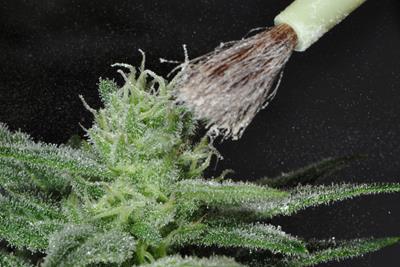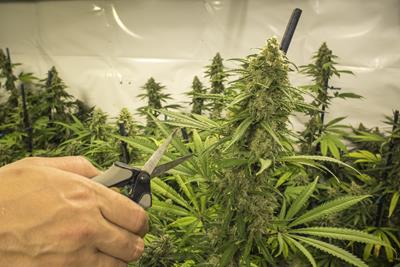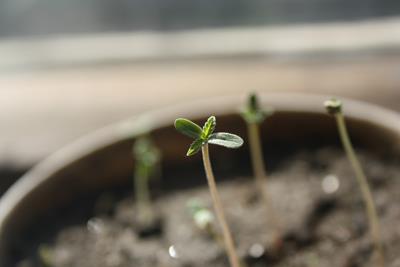
Tuesday March 15, 2022
By Paul Barach
 Growing
Growing
You’ve been growing some beginner weed strains and you ain’t bad at it. Your Cinderella 99 is the belle of the ball, and your Northern Lights twinkles bright with trichomes. An idea hits you: Why not cross breed the two into a new cannabis strain? It’ll have Cinderella 99’s cerebral booster rockets tethered by Northern Lights’ mellow body high. Seems easy enough. You dust some Northern Lights pollen onto Cinderella 99’s pistils, plant the marijuana seeds that drop, and boom! Royal Aurora! Or maybe Light Slipper? Princess Yeti? Naming is the hard part, right?
Let’s not get ahead of ourselves. While you may get your fertilized Cinderella 99 to drop some seeds, there’s no guarantee that any of the resulting plants will have the effects you want when you finally get to enjoy the fruits of your labor. Creating Princess Yeti, or any new cannabis strain that is “stabilized” with your desired traits, takes some effort, know-how, and patience.
Most importantly, don’t get discouraged. We want you to follow your weed-breeding dreams. That’s why PotGuide is here to explain how to make a new strain, what backcrossing is, how it “stabilizes” a strain, and if it’s possible for amateur growers to make the strains of their choice.
How to Make a New Strain
Keeping with the Northern Lights/Cinderella 99 example from above (you can pick any two stains), say your fertilized Cinderella 99 drops 50 seeds and miraculously, all of them sprout into mature marijuana plants. Each of those seeds is a spin of the genetic roulette wheel. There’s no guarantee that any of them will have the combination of effects that you’re looking for.
Once each Northern Lights x Cinderella 99 seedling matures, it will express its own unique phenotype (basically what the plant looks like, smells like, and does to your body when it’s fully grown).

That means that one phenotype may give you that cerebral uplift and happy body high you’re looking for in Yeti Princess, while another may express the opposite effects, making you drowsy and paranoid. Most will be somewhere in the middle. The same goes for other desired traits, like flavor, smell, yield, or pest/mold resistance.
Say that you get lucky, and one of those seeds is your ideal Yeti Princess, or close to it, in taste, smell, and effects. Congratulations, but your work isn’t over yet. You’ll have to backcross the genetics for a couple generations before Yeti Princess becomes “stabilized” enough to grow from seed every time.
What is Backcrossing?
So, you have a phenotype of Yeti Princess that’s close to your desired traits. In order to “stabilize” the strain, the next step is to backcross its genetics. Backcrossing means pollinating your new cannabis strain with the pollen of either its genetic clone, or one of its parent strains. By doing this, the next generation of Yeti Princess seeds will have those desired traits reinforced. This is how you start to “stabilize” a strain.

Besides backcrossing genetics, another option to keep your phenotype going is to clone it. You can do this either by taking a cutting and grafting it onto a receptive stem, or by getting your cutting to grow roots and planting it. The danger of this is that, if your phenotype or its clones die, that strain is lost forever.
Unstabilized vs Stabilized New Cannabis Strains
That ideal phenotype of Yeti Princess that grew from your Cinderella 99 x Northern Lights cross is what’s called an “unstabilized” strain, which means it could be carrying several phenotypes in its genetics.
When you go to plant the seeds dropped by a fertilized Yeti Princess, any number of different phenotypes could spring back up. The new plants could look, taste, smell, and have the same effects of the parent plant, or it could be the exact opposite.

That is why you want to backcross the genetics. By breeding Yeti Princess with either pollen from a clone, or from its parent strains, you’ll start to reinforce the specific effects, flavors, aromas, and other traits that you want in your new cannabis strain. With each generation, those traits become reinforced until you have a “stabilized strain.”
This means that the majority of seeds dropped by the mother plant, grown under the ideal conditions, become plants that resemble the mother in taste, effects, and appearance. Think of it as cloning, but with seeds.
The Wrap Up: Can Anyone Make a New Strain?
Let’s recap. Say that you’re a new grower and you want to cross some old favorites to make a new cannabis strain. Once you’ve pollinated your female plant with your preferred strains, you’ll need to grow as many seeds of your new cross as possible. Next, you’ll have to sample them all to find the best phenotype (this is the fun part, invite some friends).Once you’ve found the most ideal strain, it’s time to start backcrossing the genetics by pollinating your new cannabis strain with either a clone of itself or its parents. Next, you’ll grow those seeds, sample the phenotypes again, repeat for a couple generations or so until your new cannabis strain is stabilized.

The good news is, anyone can make a new, stabilized cannabis strain. In fact, most new cannabis strains were created by amateur home-growers, and usually by accident like Gorilla Glue. If you have the passion for growing and the time to raise (and sample) a couple generations of new cannabis strains, there’s no reason that you can’t develop your Yeti Princess, or whatever new cannabis strain you desire.
Frequently Ask Questions
What is the Purpose of Backcrossing?
Backcrossing reinforces the desired traits of a new cannabis strain, such as the taste, smell, effects, or yield. Eventually, when the strain becomes “stabilized,” each seed the strain produces will basically be a clone of the parent, expressing the same phenotype.
What is Backcrossing Breeding?
Backcrossing breeding means using the pollen from a genetic clone of your new cannabis strain, or from the parent strains, to ensure that your new strain continues producing buds with the same desired effects, flavors, smells, yields, or other traits.
Do you Have to Backcross a Strain to Make a New One?
You don’t have to backcross a strain to make a new one, but you will need to backcross if you want that strain to have the same desired traits every time you grow it from a seed. Otherwise you’re just smoking one offspring of the mother plant, which can’t be replicated.
Do you have any tips for backcrossing or stabilizing new cannabis strains? Anything we missed? Let us know in the comments!







